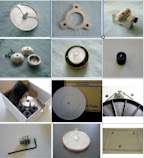Serrated three-point VTA spacers suitable for Rega tonearms
(RB100/101/202/251/301/303/330/RB700/900/1000)
0.5mm - USD 6.50
1.5mm - USD16.50
1.9mm - USD17.50
2.3mm - USD19.50
2.8mm - USD22.50
3.4mm - USD24.90
3.8mm - USD25.90
2mm - USD18.50
4mm - USD27.50
6mm - USD38.80
Since for three-point VTA spacers, most of the requirements are more than 2 mm and less than 4 mm, our three-point VTA spacers come in three sizes : 1.5mm, 2.3 mm, 2.8 mm and 3.8 mm. However, a new size of 1.9 mm is now added to the range for those who prefer 2 mm or less! Also available 0.5mm spacer for fine VTA tuning.
It's also unique because it is
serrated !
You may be puzzled to see from the picture below that the spacer is serrated at the end of the three legs ! And you would ask..... why serrated?
Top view
This is because these serrated parts, combined with the jagged edges serve to enhance the anti-resonance property of the spacers (or adjusters).

bottom view
This 3-point spacer also has the advantage over regular spacers in that the three points are designed for minimum contact area with plinth(picture above), hence better isolation from vibration. You can see from the bottom view that it's precision milled to two levels reducing the contact areas to minimum, hence less vibration is transmitted to the tonearm from board.

Designed for RB700, RB900, RB1000 tonearms, they are especially suitable for use on RB100, RB101, RB202, RB251, RB301 and RB303 tonearms as these tonearms originally are also mounted on 3-point bases (plastic ones). Changing to stainless steel spacers would increase the rigidity compared with the original all-in-one plastic VTA spacers.
What about using these spacers with RB250,RB300 and RB600 tonearms? The answer is - Yes; just use as drop-in spacers without having to drill any hole at all. With the 3-point stainless steel VTA spacers on RB250/RB300/RB600, you'll get the "semi-decoupling effect" of RB101/RB251/RB301/RB700 tonearms and yet retain the advantage of "hand-tightened" nut of RB250/RB300/RB600.
*For best performance use only one piece of suitable VTA spacer, not two or three pieces of the spacers stacked together.
Step by step to install a VTA spacer ( e.g. on Planar 3 TT):
Loosen the tonearm cable clip.
Turn the adjustable spanner anti-clockwise to loosen the tonearm hexagonal nut in order to remove the RB300 tonearm.
Now you can remove the nut by hand.
Remove the tonearm from board.
Put the serrated 3-point spacer in place.
Put back the tonearm and hand-tighten the nut (+1/4 turn). The serrated stainless steel spacer now semi-decouples the tonearm from board while maintaining the rigidity.
For tonearms with 3-point base, you may want to try this tweak :
1. You would require:
- 3 pcs M3x50mm screws
- 3 pcs butterfly nuts
2. After removing the wooden screws and tonearm, drill (3.5mm) hole straight through the plinth
3. After fixing the 3-point spacer and tonearm, hand tighten the butterfly nuts(+ 1/4 turn).
It's simple; try it out yourself ! You will hear the difference !
Further to the above tweak, you may also try this :
Adding another 3-point spacer below for even better isolation and rigidity.
* In case you can't get the M3x50mm screws and butterfly nuts, I can include 3 pcs of them with your order of VTA spacer for additional USD3.00:
Add-on to the 3-point VTA spacer : USD3.00
3 pcs stainless steel M3x50mm screws
3 pcs stainless steel butterfly nuts
3 pcs stainless steel washers











































